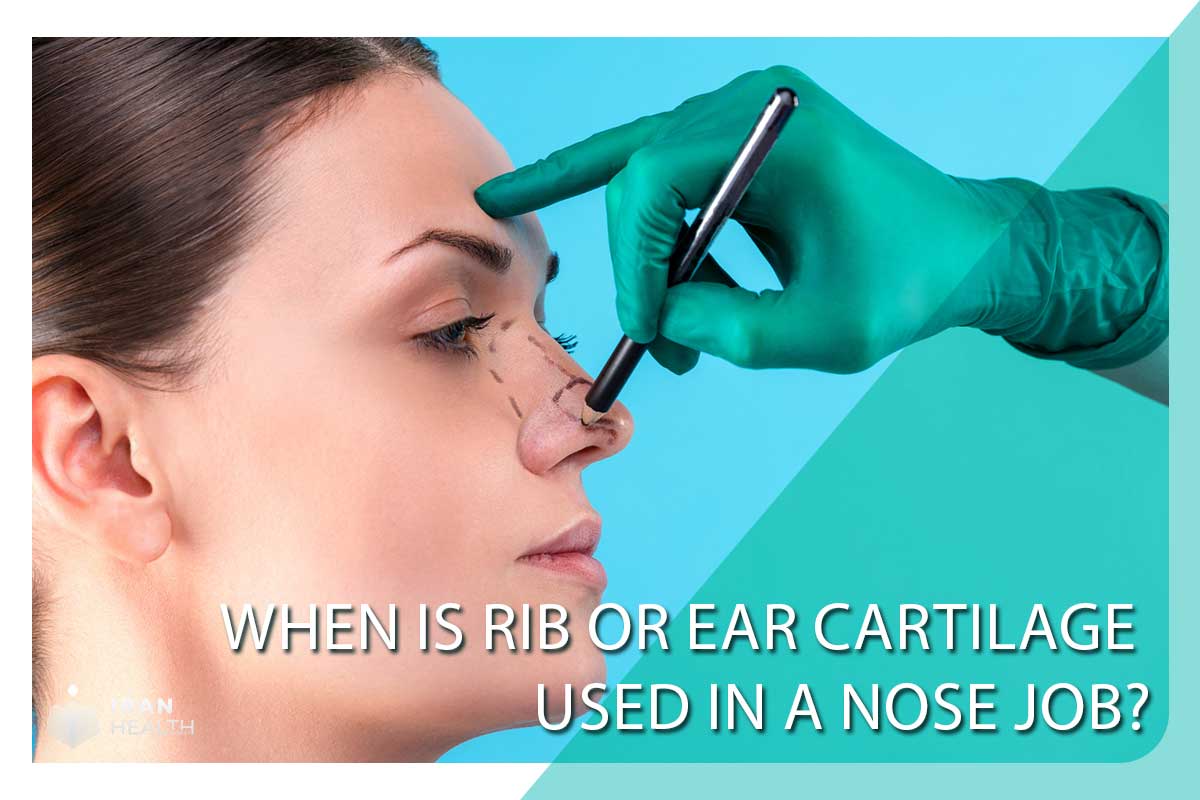When is rib or ear cartilage used in a nose job? In some rhinoplasty surgeries, surgeons use cartilage grafts from a patient’s rib or ear to achieve specific goals. Depending on individual needs and desired outcomes, rib or ear cartilage may be the preferred cartilage source for reconstruction or augmentation. Understanding when these cartilage sources are needed can help patients prepare for nose job surgery.
Rhinoplasty aims to improve the nose’s appearance and function. A surgeon may take cartilage from the patient’s ribs for major revisions, trauma repairs, and significant structural changes. Ear cartilage may be the graft source for subtle reshaping or smoothing. Based on each case, the doctor will determine the appropriate cartilage type and source.
This article will outline why rib or ear cartilage may be used during a nose job procedure. Patients can expect realistic surgery by learning when and why surgeons choose these cartilage sources.
Rib or ear cartilage grafting!
Cartilage grafting from the ribs or ears is sometimes used in rhinoplasty or nose job surgery for specific goals:
Rib cartilage:
- Major reconstruction – Rib cartilage may be used for major reconstruction if the nose requires significant structural grafting and support due to trauma, cancer, previous surgery, etc.
- Revisions – In revision rhinoplasty to rebuild structure if previous surgery depleted cartilage. Rib cartilage can provide stable, strong grafts.
- Significant augmentations – Building up a small or flattened nose may require rib cartilage to sculpt important projection and size.
Ear cartilage:
- Limited grafting – Ear cartilage suits minor grafting needs like smoothing a contour or subtle tweaks. Less invasive source.
- Ethnic rhinoplasty – Crafting a tip in ethnic rhinoplasty often uses ear cartilage grafts.
- Trauma – Ear cartilage may repair isolated trauma like fractures since it requires less graft material.
Rib cartilage is generally used for more extensive facial reconstruction, while ear cartilage is used for minor adjustments or ethnic rhinoplasty. The surgeon will assess each patient’s unique needs and goals to determine the most appropriate source of cartilage for their specific nose job.
Benefits of cartilage grafts for nose surgery
These are the significant advantages of utilizing cartilage grafts in nose surgery or rhinoplasty:
- Structure and support – Cartilage provides rigid structural support to reshape or rebuild the nose. It can be carved into precise shapes.
- Projection – Grafts can build point, and the nose bridge or tip height needs to be enhanced—more substantial support than implant materials.
- Smoothing contours – Thin cartilage grafts smooth bumps and dips along the nasal bridge or tip for a straight profile.
- Symmetry – Grafts can correct asymmetry by building up underdeveloped areas.
- Revision rhinoplasty – Cartilage grafts reconstruct noses weakened by excessive previous surgeries.
- Long lasting – Unlike synthetic implants, cartilage grafts integrate with the nose tissue and remain permanently—no risk of future resorption or rejection.
- Biocompatible – Being the patient’s tissue, there is no risk of the graft being rejected by the body.
- Natural feel and appearance – Cartilage provides a more natural look than artificial implants.
Which cartilage graft donor site is the best for rhinoplasty
When it comes to cartilage graft donor sites for rhinoplasty, there are several options:
Septal cartilage – Cartilage from the septum inside the nose is commonly used. It is easy to access and reshape during surgery. However, the amount of usable septal cartilage varies between patients.
Ear cartilage can be taken from the ear, usually from the concha or tragus areas. This is ideal for tiny grafts needed to smooth contours or tip grafts. It leads to minimal donor site morbidity.
Rib cartilage – Cartilage harvested from the ribs provides a significant, vital source for major structural reconstruction. However, it creates more pain at the donor site during recovery.
There is no single ” ideal ” donor site. The appropriate source depends on the surgery goals and needs of the individual patient:
- Septal cartilage is ideal for minor grafts in primary rhinoplasties.
- Ear cartilage suffices for ethnic rhinoplasties and smoothing edges.
- Rib cartilage is reserved for significant revisions, trauma repairs, and reconstructions requiring substantial grafts.
The rhinoplasty surgeon will determine the optimal cartilage donor site based on the amount, strength, and carving properties needed to achieve the desired aesthetic outcomes. Their experience and training help them choose wisely.
know about: 17 Tips that you should Know About Meaty or Fleshy Rhinoplasty!
What types of nose deformity can be fixed with a cartilage graft nose job?
Here are some examples of nasal deformities and issues that can be improved with cartilage graft rhinoplasty:
- Saddle nose deformity – Loss of bridge height can be corrected by building up the area with cartilage grafts.
- Pinched tip – Grafts can reinforce a pinched, narrowed or pointy tip to refine the shape.
- Crooked nose – Grafts can straighten a deviated or crooked nose by reinforcing the crooked side.
- Wide nose – Cartilage grafts along the sidewalls can refine and narrow a broad nose.
- Hump removal – After removing a dorsal hump, grafts smooth any irregularities on the bridge.
- Cleft lip nose – Grafts can reinforce a cleft lip nose and refine an asymmetrical tip.
- Revision rhinoplasty – Rebuild or reinforce a nose weakened by previous surgery with structural grafts.
- Trauma repair – Fractures or trauma defects can be reconstructed with cartilage grafting.
- Birth defects – Congenital defects like underdeveloped features can be augmented with grafts.
When used by a skilled surgeon, cartilage grafts can effectively address nasal imperfections and deformities. Modifying and augmenting the nasal structure is accomplished.
Rib cartilage risks:
- Increased pain – Harvesting rib cartilage can lead to additional postoperative pain, discomfort, and risk of infection at the donor site.
- Pneumothorax – The chest cavity can accidentally be penetrated during rib harvesting, resulting in lung collapse (pneumothorax).
- Chest contour irregularity – Removing part of a rib may cause depression or concavity on the chest wall.
Ear cartilage risks:
- Ear deformity – Removing too much ear cartilage can lead to an unnatural shape or contour deformity of the ear.
- External scar – A tiny spot may be left outside the ear at the cartilage donor site.
- Loss of structural support – Over-resection of ear cartilage risks decreasing the ear’s natural structural support.
- Reduced circulation – The ear cartilage donor site can temporarily have reduced blood circulation, risking tissue damage.
- Loss of sensation – Some loss of sensation in the ear or around the cartilage removal site may occur.
General risks:
- Graft displacement – The rib or ear cartilage graft used in the nose could shift out of place after surgery.
- Extrusion – In rare cases, the body may reject the cartilage graft, causing it to extrude from the nose.
- Infection – Like any surgery, there is a small risk of infection developing in the nose or at the cartilage donor site.
FAQ about rib or ear cartilage used in a nose job!
Why use cartilage grafts in nose surgery?
Cartilage grafts allow surgeons to reinforce or reshape the nose structure permanently. They provide long-lasting support, projection, and smoothing capabilities.
What are the different cartilage graft sources?
Common donor sites are the nasal septum, ear, and ribs. Each has advantages based on the amount of cartilage needed and the complexity of the nose job.
How do rib cartilage grafts work?
The surgeon removes cartilage from the rib cage through a small incision. This sturdy cartilage can rebuild noses needing major structural grafting.
What is ear cartilage used for in rhinoplasty?
Cartilage from the ear concha or tragus is commonly used to subtly smooth contours and graceful refinements, especially in ethnic rhinoplasty.
Are cartilage grafts painful?
Donor sites may experience temporary soreness, but this is managed with medication. The nose itself will not feel pain from the cartilage graft.
What makes cartilage better than implants?
Cartilage integrates naturally with the nose tissue, unlike synthetics. There is no risk of future resorption, rejection, or extrusion over time.
How long do nose cartilage grafts last?
Cartilage grafts are permanent and do not need replacement or revision over time like implants. The grafts integrate naturally into the nose structure and maintain their shape lifelong.
Can a cartilage graft become visible after rhinoplasty?
Expertly placed and carved grafts should not be visible under the skin post-surgery. In rare cases, an irregularity may show if the skin is fragile.
What are spreader grafts?
Spreader grafts between the septum and upper lateral cartilages can straighten a crooked nose and smooth an irregular dorsum.
When would septal extension grafts be used?
They lengthen the septum to help increase the projection and rotation of the nasal tip, which is especially useful in ethnic rhinoplasties.
How thick are cartilage grafts for the nose?
Thickness ranges from 1-4mm usually. Thinner grafts smooth contours, while thicker grafts provide structural support.
How long is the cartilage graft rhinoplasty recovery?
Initial swelling subsides within two weeks, but final refinement of the nose shape continues for up to a year as the grafts fully integrate.
Related post



